If you love the look of vintage bathrooms or want a tub that truly stands the test of time, a cast iron bathtub may be just what you need. Cast iron tubs have been around for well over a century and their durability and retro styling remain appealing to many homeowners today.
So, everything about cast iron bathtubs – from how they’re made to their many styles, features, installation, care, and more. Let’s dive in to see why cast iron remains a top tub material.
Top 10 Recommendations For Best Cast Iron Bathtubs

61″ Cast Iron Slipper Clawfoot
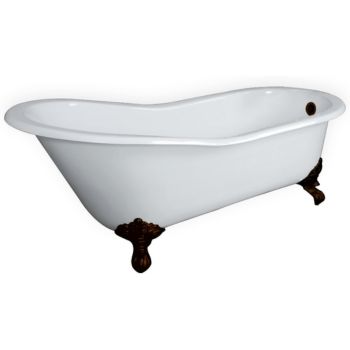
67″ Cast Iron Slipper Tub
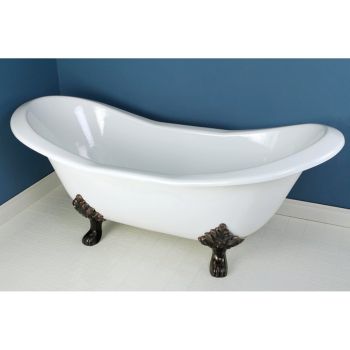
Kingston Brass Aqua Eden
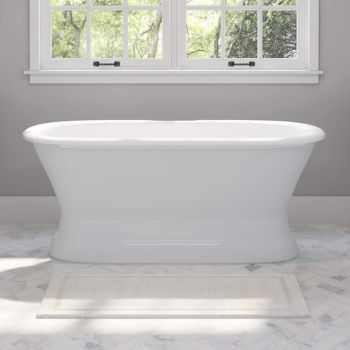
60″ Cast Iron Double Ended

71″ Cast Iron Double Ended
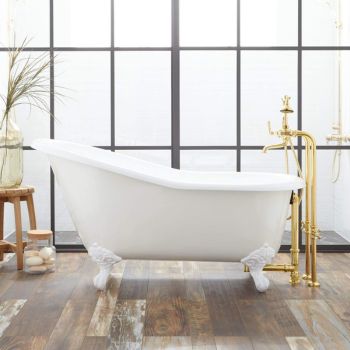
Signature Hardware 144838 Erica 57″ Cast Iron

71″ Cast Iron Double Ended Slipper
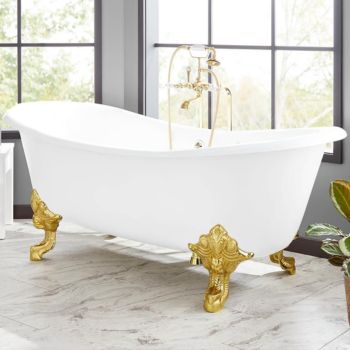
Signature Hardware 312541 Lena 72″

Signature Hardware 275846 Henley 60″

Signature Hardware 291687 Sanford 66″
What are cast iron bathtubs?
Cast iron tubs are made by pouring molten iron into a mold to form the tub shape. The cast iron maintains heat beautifully and gives the tub heft and stability. The exterior is then covered with a baked-on porcelain enamel coating. This glossy enamel protects the iron and comes in a variety of hues.
Benefits of cast iron tubs
Cast iron has stood the test of time as a trusted tub material thanks to these advantages:
- Extremely durable – Cast iron tubs can last 50 years or more with care. The thick iron retains its shape and strength for decades.
- Unmatched heat retention – Cast iron excels at absorbing and retaining heat. Its thickness means the warmth lasts extra long.
- Vintage aesthetic – From clawfeet to sleek curves, cast iron has iconic vintage styling. Even new tubs capture this old-world charm.
- Enamel color options – The porcelain enamel coating comes in white, black, almond, and other shades to suit your décor.
- Antique reproductions – Many companies recreate elaborate, decorative antiques if you want an authentic retro look.
- Adds character – The elegance and weight of a cast iron tub gives a bathroom a unique character.
Clearly cast iron has compelling benefits if you value timeless bathroom style and durable quality.
Cast iron tub pros and cons
No material is perfect, so cast iron does have a few potential drawbacks:
Pros:
- Extremely long-lasting
- Unbeatable heat retention
- Nostalgic, vintage styling
- High resale value
Cons:
- Very heavy, difficult to maneuver and install
- More expensive than acrylic or fiberglass
- Can chip and stain over time
- Difficult to repair damage
The number one complaint about cast iron is its heaviness, making installation arduous. The cost and potential for enamel damage are other considerations. But fans of their durability and charm minimize the cons.
Factors to consider when choosing a cast iron tub
Here are the key things to weigh when shopping for cast iron bathtubs:
- Size – Measure your space to get the right tub length and depth. Allow room to enter and exit comfortably.
- Weight – Consider if your floor can support 400-700 pounds before installing cast iron.
- Style – Choose from classic clawfoot, retrofitted alcove, or vintage slipper and double slipper tubs.
- Material thickness – Thicker cast iron retains more heat but is heavier. Standard thickness is 3/16″ but some tubs are 5/16″ or more.
- Color – White, black, almond, and biscuit enamels blend with most decors. Or choose unique hues like green or blue.
- Special features – Look for characteristics like integrated soap trays, contoured headrests, or textured bottoms you prefer.
Start your cast iron tub search by outlining your needs like space, weight capacity, and style. This helps narrow options.
Types of Cast Iron Bathtubs
Cast iron as a material works across many tub shapes and styles. Here are some of the most common types you’ll come across:
Classic cast iron clawfoot tubs
This iconic tub style features four ball-and-claw style feet supporting the freestanding tub. Many clawfoot tubs have sleek, rolled edges and high sides. You can find authentic antique clawfoot tubs as well as reproduction styles. Make sure to select a tub long enough to stretch out and soak.
Built-in cast iron alcove tubs
Many cast iron tubs are designed to fit within a standard alcove. These offer the durability of cast iron in a typical built-in tub design for easy retrofitting to replace an old alcove tub. Porcelain finishes blend with surrounding tile and fixtures.
Corner cast iron tubs
L-shaped corner tubs maximize small or oddly shaped bathrooms. Cast iron corner tubs come in triangular and neo-angle shapes to tuck neatly into a corner while opening up floor space.
Slipper cast iron tubs
Slipper tubs have one rounded end and one fairly flat end. This elongated oval shape allows bathers to recline against the flat end. Many feature ornate detailing like claw feet and classic faucet drillings on the flat end.
Double-slipper cast iron tubs
As the name implies, double-slipper tubs offer a rounded backrest at both ends for two bathers. Two flat sides maximize lounging room for a couple to enjoy a relaxing soak together.
Shopping by the style you find most appealing helps narrow the many cast iron tub options.
Cast Iron Bathtub Features
Beyond basic shapes, cast iron bathtubs boast many features that enhance functionality and look. Here are some top considerations:
Porcelain enamel exterior finish
The coated porcelain surface mimics the classic look of enamel steel tubs. Smooth and glossy enamel comes in white, almond, biscuit and other shades to suit your vision. Black enamel creates a striking dramatic statement.
Variety of colors and finishes
Some companies offer unique enameled finishes beyond basic colors, including:
- Faux copper or bronze
- Antique wood tones
- Faded vintage patinas
- Marbleized multicolor swirls
- Metallic finishes like nickel, gold or silver
Consider finishes that complement your décor.
Heat retention properties
Cast iron absorbs and retains heat beautifully thanks to its thickness and density. The bath water stays hot for an extra luxurious soak compared to thinner metals or plastics. Nothing beats cast iron for its unrivaled heat capacity.
Long-lasting durability
Between the tough cast iron and protective enamel coating, these tubs resist scratches, chips, and corrosion for decades – even lifetimes in some cases. Periodic maintenance keeps them looking pristine.
Vintage and antique styling
From clawfoot and slipper shapes to ornamental details, cast iron oozes with old-fashioned charm. Companies recreate historic 1800s tubs for those seeking an authentically antique aesthetic. The options capture any era.
If you want spa-like heat retention, choose a cast iron tub. Seeking decorative detailing? Cast iron delivers with elegance. This versatility makes cast iron a go-to material for all design styles.
Installing a Cast Iron Tub
One downside of cast iron tubs is their extremely heavy weight – averaging 300 to 700 pounds! That makes installation more complex than lighter acrylic or fiberglass tubs. Here are tips for smoothly installing your cast iron bathtub:
Preparing and leveling the area
As with any tub, start by removing old fixtures and ensuring the floor is level and reinforced to hold the immense weight. Check that floorboards are solid with ample basement or crawl space clearance underneath for pipes.
Planning for weight and support
Know your tub’s weight and factor that in during planning. Have strong helpers ready to assist in maneuvering the tub into place. Ensure floor joists are sturdy and use extra supports like new 2x4s if needed.
Securing the tub in place
Set the tub where desired and use shims to ensure it sits evenly with no rocking. Attach metal cleats or ledger boards along the studs to create a resting spot for the tub lip. The lip should fit snugly on the boards to anchor the weight.
Connecting plumbing
With the tub settled in, add drain and water supply plumbing. Cast iron tubs use standard tub drain kits and supply hookups. Ensure tight seals.
Caulking and sealing
Apply a bead of tub and tile caulk around the base where the tub meets the floor. Check for any gaps between the tub and walls and caulk those too for a watertight seal.
The main challenge is the weight, so having professional installers or very strong helpers is recommended to maneuver cast iron tubs into place without damaging the floor or enamel. But once in place, it will serve faithfully.
Cleaning and Maintaining Cast Iron Tubs
To keep your cast iron tub’s enameled surface looking fresh, avoid abrasive cleaners or scouring pads. Harsh chemicals can damage the finish over time. Follow these care guidelines:
Protecting the finish
- Use a mild detergent and a soft sponge or cloth to clean the surface. Avoid abrasive powders or pads.
- Rinse the tub thoroughly after cleaning to remove residue.
- Dry the tub with a soft towel after bathing to prevent water spots.
- Consider applying a thin coat of car wax occasionally to boost shine and water beading.
Removing stains and mineral deposits
- For light stains, wipe with a paste of baking soda and water. Rinse thoroughly.
- Remove more stubborn stains with white vinegar. Let it sit then scrub gently.
- For mineral buildup in hard water areas, use a limescale remover designed for tubs.
Avoiding chips and cracks
- Always enter and exit the tub cautiously. Quick movements can chip the enamel.
- Never step into a dry tub bottom. The impact can crack or chip the surface.
- Use a tub mat to prevent slipping and protect the bottom from impacts.
Refinishing or resurfacing enamel
- If chips, cracks, or scratches occur, the enamel can be re-enameled by a professional.
- Refinishing restores the like-new sheen and protects the iron underneath.
Take care when cleaning and using your cast iron tub to maintain its vintage beauty. Refinishing restores any surface damage.
Costs of Cast Iron Bathtubs
Given the thick iron construction and hand finishing, cast iron tubs sit at the higher end of the price spectrum:
Economy models
- Simple clawfoot tub – $800 – $1,500
- Basic corner tub – $900 – $2,000
- Short alcove tub – $1,000 – $2,000
Mid-range cast iron tubs
- Decorative clawfoot with enamel finish – $1,500 – $3,000
- Double slipper tub – $2,500 – $4,000
- Stone-patterned corner tub – $2,800 – $4,500
High-end antique reproductions
- Ornate antique slipper tub with details – $4,000 – $8,000
- Elaborate decorative clawfoot tub – $5,000 – $10,000
- Custom extra-long, extra-deep tub – $8,000+
Cast iron definitely comes at a premium. But devotees feel the unmatched durability and luxurious bathing experience justify the investment.
Conclusion
Cast iron bathtubs offer a bridge back to bathing’s vintage roots thanks to the material’s steadfast durability and heritage styling. The thick iron holds heat like no other material for truly tranquil soaking. While heavy and expensive, cast iron tubs pay back the cost through their enduring service life when properly cared for.
If a touch of luxury and nostalgia suits your bath sanctuary plans, take time to seek out your perfect cast iron tub. The right tub becomes a beloved heirloom-quality fixture for generations to enjoy. Treat yourself to some old-fashioned bathing bliss!
See more:
